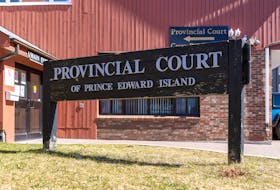SOUTH WINSLOE, P.E.I. - A sandstone house in South Winsloe has a lot of history in its walls.
And if the past 180-plus years are any indication, the home at 948 Winsloe Rd. will be able to tell that history for decades to come.
“It’s a solid old house,” said owner Leslie Jay, who purchased the home with his wife Gail Carter-Jay about 20 years ago. “It’s in incredible shape and it hasn’t deteriorated since we bought it.”

The house, known as Barton Lodge, is one of only a handful of 19th-century sandstone homes remaining in P.E.I.
After publishing a story on sandstone being used for Province House renovations, The Guardian received several inquiries from individuals on the use and availability of sandstone in construction.
While Parks Canada employees said they were previously unable to find a reliable source of hard Island sandstone, Jay noted his home was built using stones from a quarry just behind the house and has been open to the elements since its construction in 1834.
“It’s never been covered and (the stone) was mined just two fields back from this property,” said Jay, adding that while the house has seen some changes through the years it has remained structurally sound.
He was told the reason behind the house’s durability was the moisture, or lack thereof, on the foundation.
“The secret to it is that the foundation is dry, and this was built right on a hill,” he said. “There is no moisture… This basement is dry because there’s drainage in every direction.”
Part of the home’s historical draw is that it was designed by architect Isaac Smith, who also designed Province House, Fanningbank and the Point Prim Lighthouse.
While the Canadian Register of Historic Places says Barton Lodge was constructed in 1844, it appears the structure was actually completed about 10 years earlier.
Jay said he has previously seen the construction listed as 1834, which one of the former owners also believed. It would also make little sense for Smith and contractors to be working on the house in 1844 when construction on the much larger Province House was already underway.
However, the most telling piece of evidence may be a stone on the side of the house, which has carvings reading “Barton Lodge” and “Buxton 1834.”
The lodge was originally built for merchant Edward Buxton and his wife, who came to P.E.I. from England in 1826.
Originally serving as a small hotel connecting the shore and the city, the home also included a pub. About 60 years after its construction, the hotel wing was removed, while eastern and western porches have since been added.
The only notable improvement Jay had to make to the house when moving in was raising an area of the floor, which was caused by a wall not being constructed over a carrying beam.
The house is a registered heritage place, which means it has been deemed to be a provincial heritage resource but does not have any restrictions in place.
Jay said he has thought about looking into heritage designation, which is the highest level of recognition for historical significance in the province.
If designated, the home would be safeguarded for decades to come.
“We were wondering about doing that because it has no protection,” said Jay. “People have been saying we should get it designated as heritage because if you don’t, it could be torn down by whoever buys it.”









